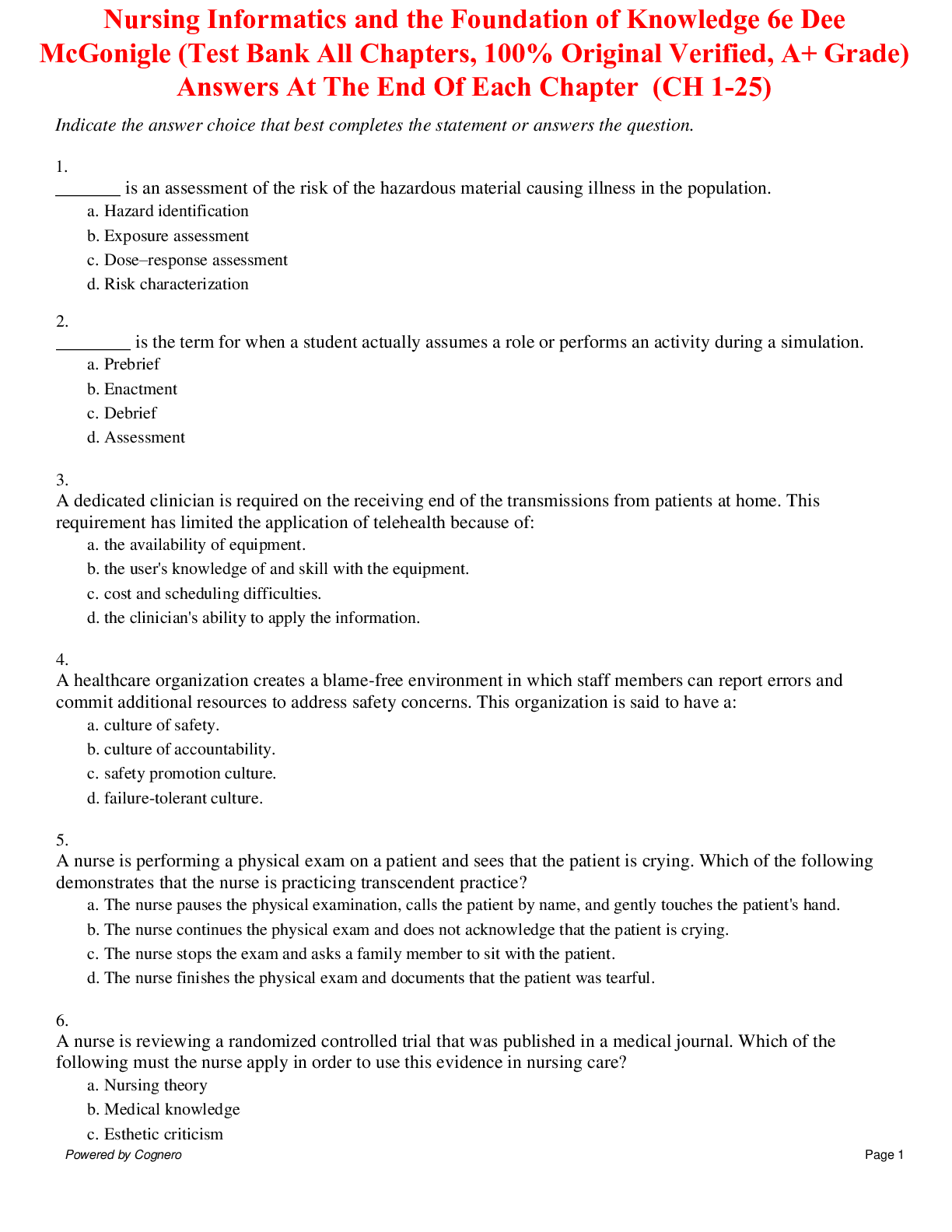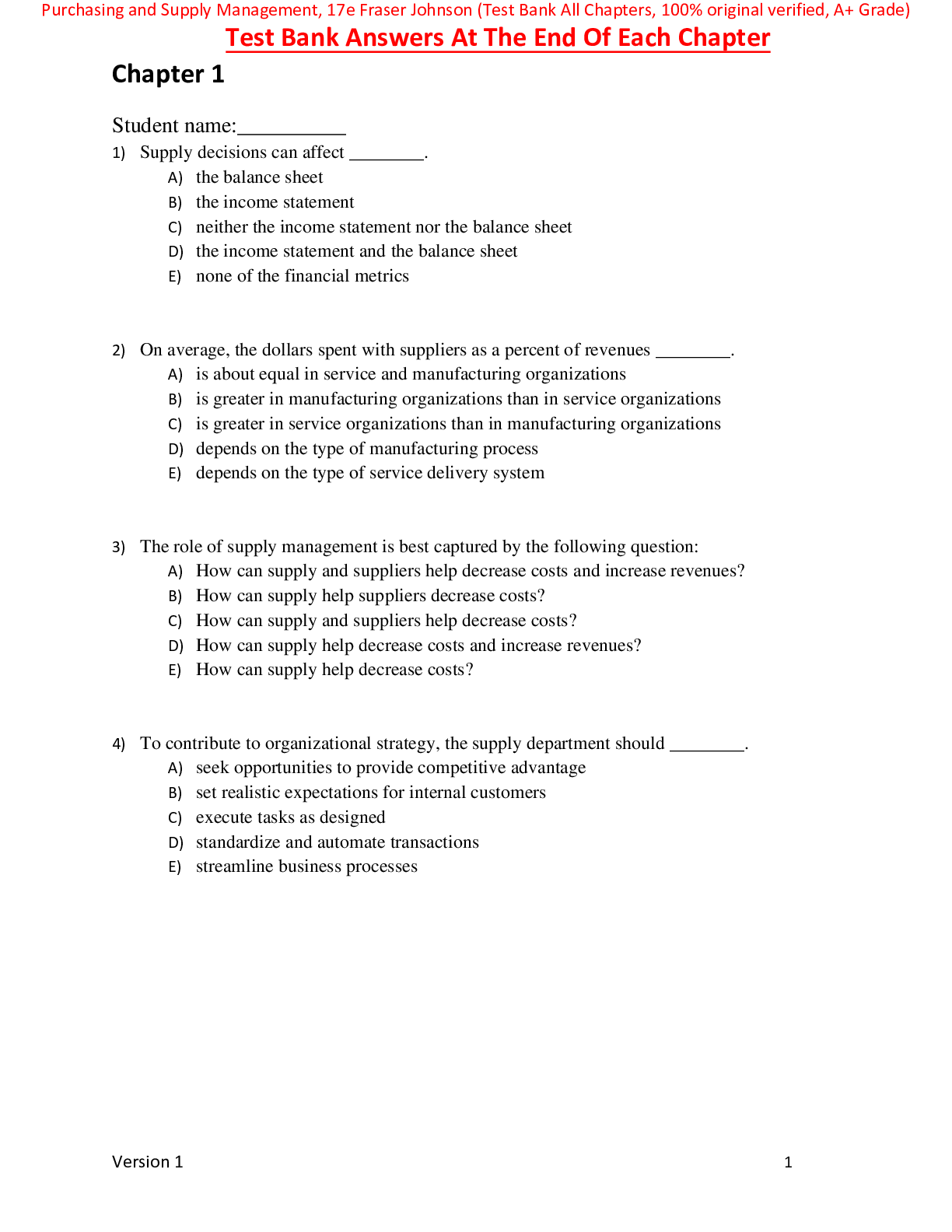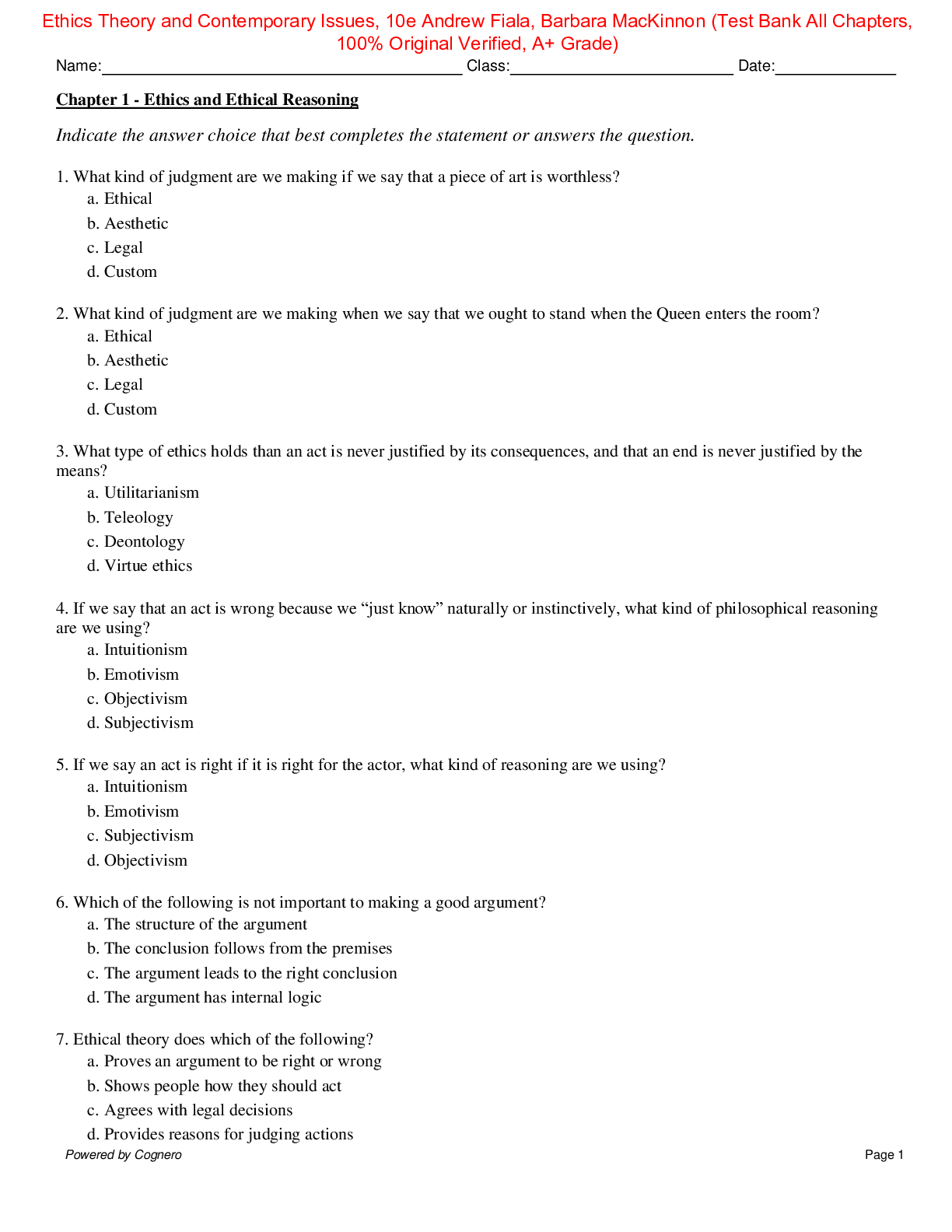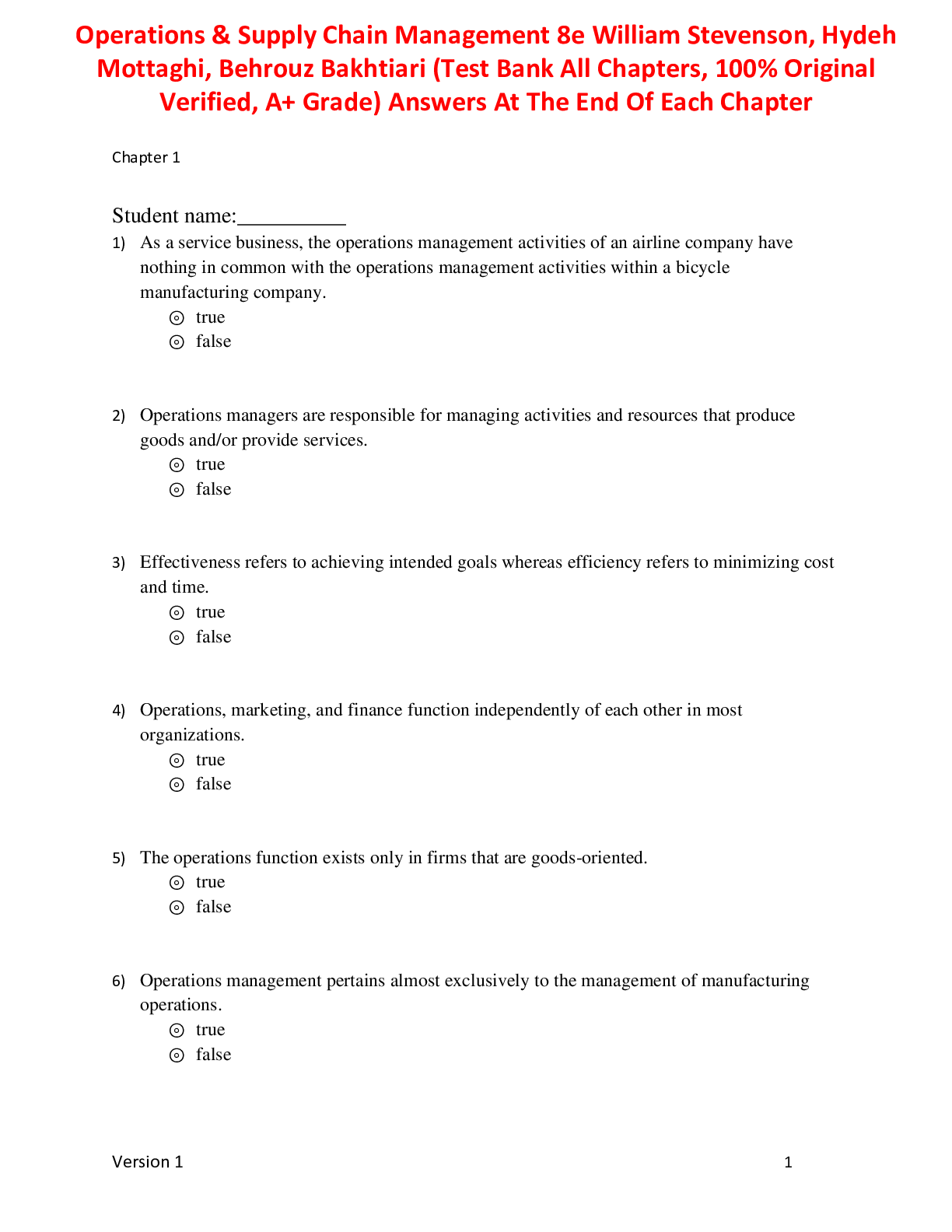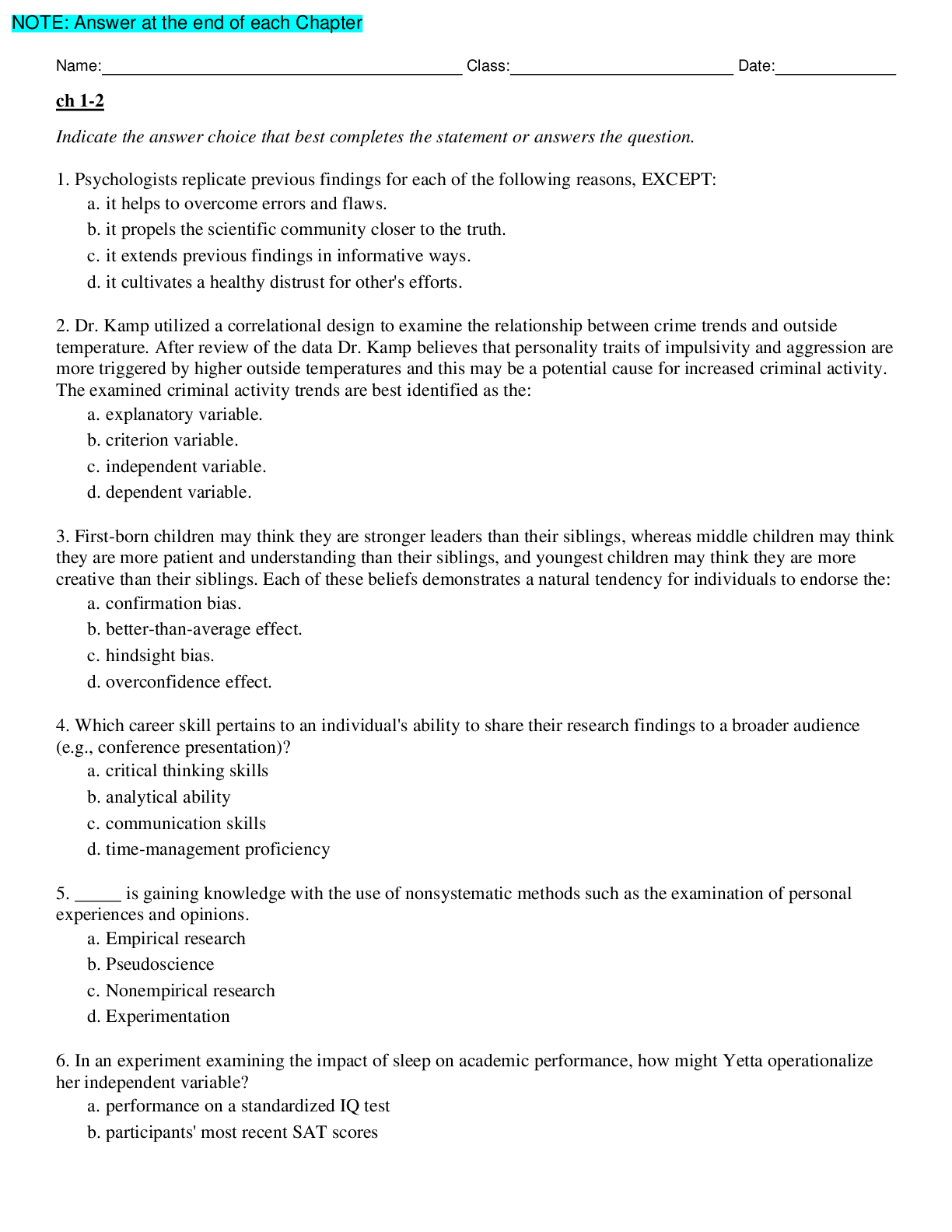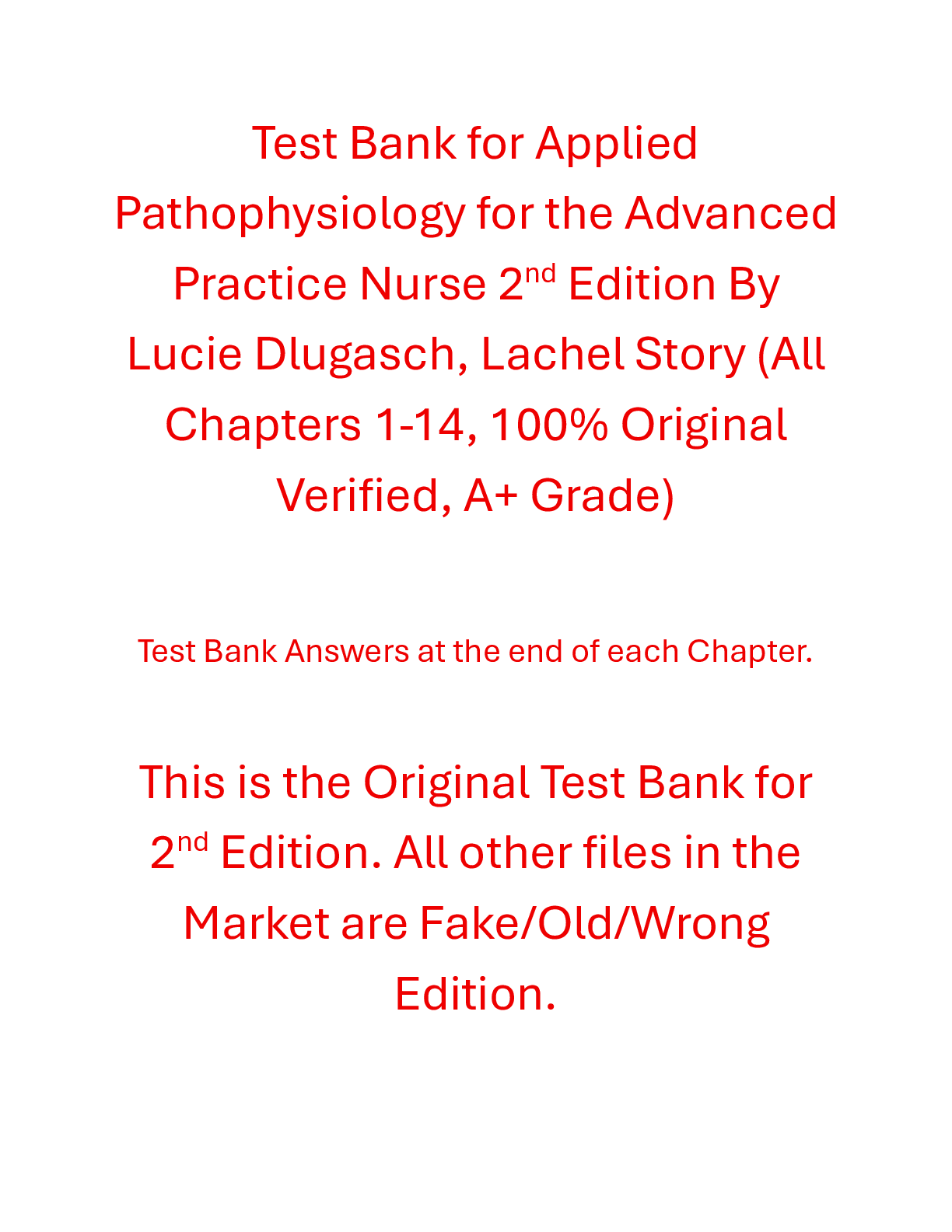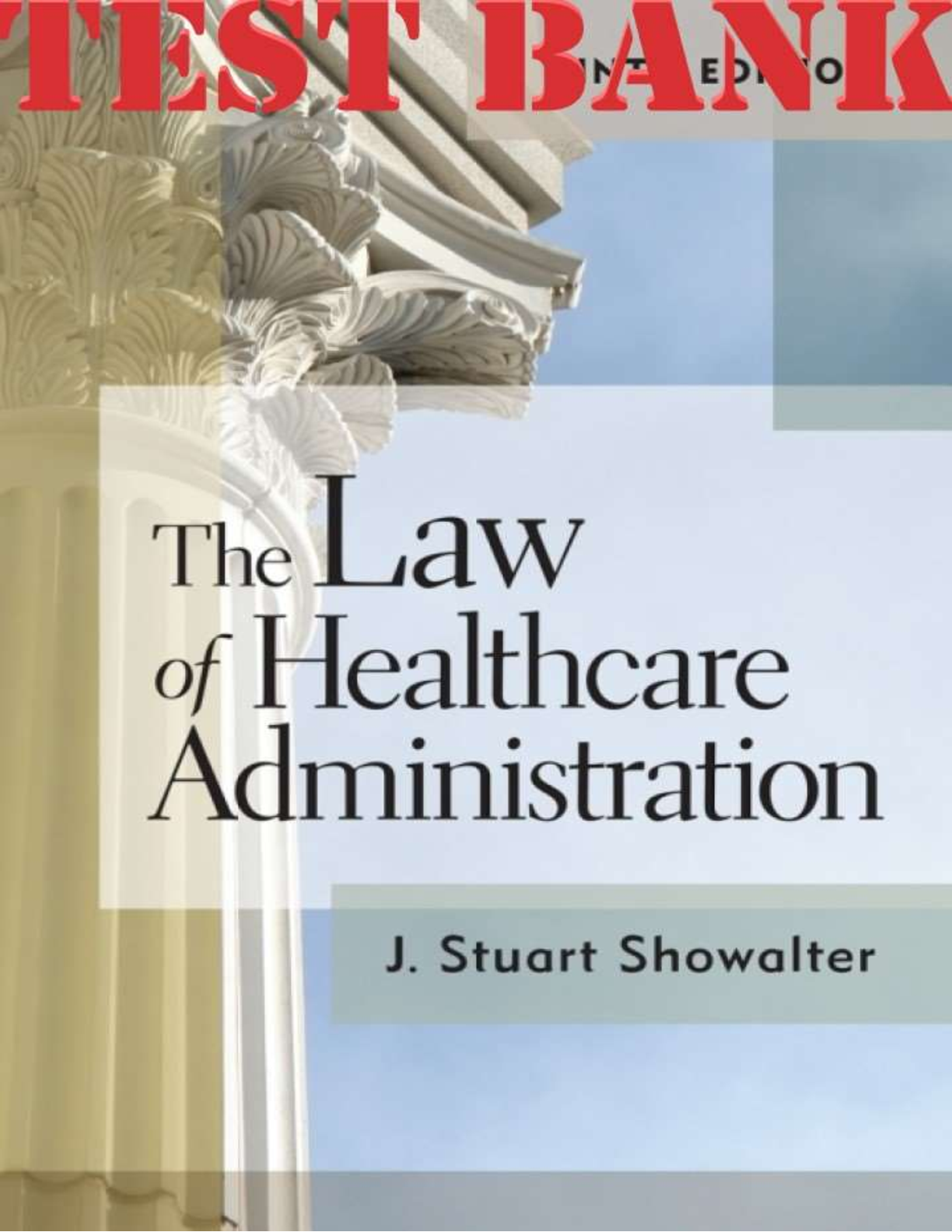Microeconomics > TEST BANK > Test Bank for Intermediate Microeconomics A Modern Approach 9th Edition by Hal Varian (All)
Test Bank for Intermediate Microeconomics A Modern Approach 9th Edition by Hal Varian
Document Content and Description Below
Test Bank for Intermediate Microeconomics A Modern Approach 9th Edition by Hal Varian Intermediate Microeconomics, 9e Title Page Copyright Dedication Contents Preface 1. The Market 1.1 Constru... cting a Model 1.2 Optimization and Equilibrium 1.3 The Demand Curve 1.4 The Supply Curve 1.5 Market Equilibrium 1.6 Comparative Statics 1.7 Other Ways to Allocate Apartments The Discriminating Monopolist The Ordinary Monopolist Rent Control 1.8 Which Way Is Best? 1.9 Pareto Efficiency 1.10 Comparing Ways to Allocate Apartments 1.11 Equilibrium in the Long Run Summary Review Questions 2. Budget Constraint 2.1 The Budget Constraint 2.2 Two Goods Are Often Enough 2.3 Properties of the Budget Set 2.4 How the Budget Line Changes 2.5 The Numeraire 2.6 Taxes, Subsidies, and Rationing Example: The Food Stamp Program 2.7 Budget Line Changes Summary Review Questions 3. Preferences 3.1 Consumer Preferences 3.2 Assumptions about Preferences 3.3 Indifference Curves 3.4 Examples of Preferences Perfect Substitutes Perfect Complements Bads Neutrals Satiation Discrete Goods 3.5 Well-Behaved Preferences 3.6 The Marginal Rate of Substitution 3.7 Other Interpretations of the MRS 3.8 Behavior of the MRS Summary Review Questions 4. Utility 4.1 Cardinal Utility 4.2 Constructing a Utility Function 4.3 Some Examples of Utility Functions Example: Indifference Curves from Utility Perfect Substitutes Perfect Complements Quasilinear Preferences Cobb-Douglas Preferences 4.4 Marginal Utility 4.5 Marginal Utility and MRS 4.6 Utility for Commuting Summary Review Questions Appendix Example: Cobb-Douglas Preferences 5. Choice 5.1 Optimal Choice 5.2 Consumer Demand 5.3 Some Examples Perfect Substitutes Perfect Complements Neutrals and Bads Discrete Goods Concave Preferences Cobb-Douglas Preferences 5.4 Estimating Utility Functions 5.5 Implications of the MRS Condition 5.6 Choosing Taxes Summary Review Questions Appendix Example: Cobb-Douglas Demand Functions 6. Demand 6.1 Normal and Inferior Goods 6.2 Income Offer Curves and Engel Curves 6.3 Some Examples Perfect Substitutes Perfect Complements Cobb-Douglas Preferences Homothetic Preferences Quasilinear Preferences 6.4 Ordinary Goods and Giffen Goods 6.5 The Price Offer Curve and the Demand Curve 6.6 Some Examples Perfect Substitutes Perfect Complements A Discrete Good 6.7 Substitutes and Complements 6.8 The Inverse Demand Function Summary Review Questions Appendix 7. Revealed Preference 7.1 The Idea of Revealed Preference 7.2 From Revealed Preference to Preference 7.3 Recovering Preferences 7.4 The Weak Axiom of Revealed Preference 7.5 Checking WARP 7.6 The Strong Axiom of Revealed Preference 7.7 How to Check SARP 7.8 Index Numbers 7.9 Price Indices EXAMPLE: Indexing Social Security Payments Summary Review Questions 8. Slutsky Equation 8.1 The Substitution Effect EXAMPLE: Calculating the Substitution Effect 8.2 The Income Effect EXAMPLE: Calculating the Income Effect 8.3 Sign of the Substitution Effect 8.4 The Total Change in Demand 8.5 Rates of Change 8.6 The Law of Demand 8.7 Examples of Income and Substitution Effects Example: Rebating a Tax Example: Voluntary Real Time Pricing 8.8 Another Substitution Effect 8.9 Compensated Demand Curves Summary Review Questions Appendix Example: Rebating a Small Tax 9. Buying and Selling 9.1 Net and Gross Demands 9.2 The Budget Constraint 9.3 Changing the Endowment 9.4 Price Changes 9.5 Offer Curves and Demand Curves 9.6 The Slutsky Equation Revisited 9.7 Use of the Slutsky Equation Example: Calculating the Endowment Income Effect 9.8 Labor Supply The Budget Constraint 9.9 Comparative Statics of Labor Supply Example: Overtime and the Supply of Labor Summary Review Questions Appendix 10. Intertemporal Choice 10.1 The Budget Constraint 10.2 Preferences for Consumption 10.3 Comparative Statics 10.4 The Slutsky Equation and Intertemporal Choice 10.5 Inflation 10.6 Present Value: A Closer Look 10.7 Analyzing Present Value for Several Periods 10.8 Use of Present Value Example: Valuing a Stream of Payments Example: The True Cost of a Credit Card Example: Extending Copyright 10.9 Bonds Example: Installment Loans 10.10 Taxes EXAMPLE: Scholarships and Savings 10.11 Choice of the Interest Rate Summary Review Questions 11. Asset Markets 11.1 Rates of Return 11.2 Arbitrage and Present Value 11.3 Adjustments for Differences among Assets 11.4 Assets with Consumption Returns 11.5 Taxation of Asset Returns 11.6 Market Bubbles 11.7 Applications Depletable Resources When to Cut a Forest Example: Gasoline Prices during the Gulf War 11.8 Financial Institutions Summary Review Questions Appendix 12. Uncertainty 12.1 Contingent Consumption Example: Catastrophe Bonds 12.2 Utility Functions and Probabilities Example: Some Examples of Utility Functions 12.3 Expected Utility 12.4 Why Expected Utility Is Reasonable 12.5 Risk Aversion Example: The Demand for Insurance 12.6 Diversification 12.7 Risk Spreading 12.8 Role of the Stock Market Summary Review Questions Appendix Example: The Effect of Taxation on Investment in Risky Assets 13. Risky Assets 13.1 Mean-Variance Utility 13.2 Measuring Risk 13.3 Counterparty Risk 13.4 Equilibrium in a Market for Risky Assets 13.5 How Returns Adjust EXAMPLE: Value at Risk EXAMPLE: Ranking Mutual Funds Summary Review Questions 14. Consumer’s Surplus 14.1 Demand for a Discrete Good 14.2 Constructing Utility from Demand 14.3 Other Interpretations of Consumer’s Surplus 14.4 From Consumer’s Surplus to Consumers’ Surplus 14.5 Approximating a Continuous Demand 14.6 Quasilinear Utility 14.7 Interpreting the Change in Consumer’s Surplus Example: The Change in Consumer’s Surplus 14.8 Compensating and Equivalent Variation Example: Compensating and Equivalent Variations Example: Compensating and Equivalent Variation for Quasilinear Preferences 14.9 Producer’s Surplus 14.10 Benefit-Cost Analysis Rationing 14.11 Calculating Gains and Losses Summary Review Questions Appendix Example: A Few Demand Functions Example: CV, EV, and Consumer's Surplus 15. Market Demand 15.1 From Individual to Market Demand 15.2 The Inverse Demand Function Example: Adding Up “Linear” Demand Curves 15.3 Discrete Goods 15.4 The Extensive and the Intensive Margin 15.5 Elasticity Example: The Elasticity of a Linear Demand Curve 15.6 Elasticity and Demand 15.7 Elasticity and Revenue Example: Strikes and Profits 15.8 Constant Elasticity Demands 15.9 Elasticity and Marginal Revenue Example: Setting a Price 15.10 Marginal Revenue Curves 15.11 Income Elasticity Summary Review Questions Appendix Example: The Laffer Curve Example: Another Expression for Elasticity 16. Equilibrium 16.1 Supply 16.2 Market Equilibrium 16.3 Two Special Cases 16.4 Inverse Demand and Supply Curves Example: Equilibrium with Linear Curves 16.5 Comparative Statics Example: Shifting Both Curves 16.6 Taxes Example: Taxation with Linear Demand and Supply 16.7 Passing Along a Tax 16.8 The Deadweight Loss of a Tax Example: The Market for Loans Example: Food Subsidies Example: Subsidies in Iraq 16.9 Pareto Efficiency EXAMPLE: Waiting in Line Summary Review Questions 17. Measurement 17.1 Summarize data Example: Simpson’s paradox 17.2 Test 17.3 Estimating demand using experimental data 17.4 Effect of treatment 17.5 Estimating demand using observational data Functional form Statistical model Estimation 17.6 Identification 17.7 What can go wrong? 17.8 Policy evaluation Example: Crime and police Summary Review Questions 18. Auctions 18.1 Classification of Auctions Bidding Rules 18.2 Auction Design Example: Goethe’s auction 18.3 Other Auction Forms Example: Late Bidding on eBay 18.4 Position Auctions Two Bidders More Than Two Bidders Quality Scores 18.5 Should you advertise on your brand? 18.6 Auction revenue and number of bidders 18.7 Problems with Auctions Example: Taking Bids Off the Wall 18.8 The Winner’s Curse 18.9 Stable Marriage Problem 18.10 Mechanism Design Summary Review Questions 19. Technology 19.1 Inputs and Outputs 19.2 Describing Technological Constraints 19.3 Examples of Technology Fixed Proportions Perfect Substitutes Cobb-Douglas 19.4 Properties of Technology 19.5 The Marginal Product 19.6 The Technical Rate of Substitution 19.7 Diminishing Marginal Product 19.8 Diminishing Technical Rate of Substitution 19.9 The Long Run and the Short Run 19.10 Returns to Scale Example: Datacenters Example: Copy Exactly! Summary Review Questions 20. Profit Maximization 20.1 Profits 20.2 The Organization of Firms 20.3 Profits and Stock Market Value 20.4 The Boundaries of the Firm 20.5 Fixed and Variable Factors 20.6 Short-Run Profit Maximization 20.7 Comparative Statics 20.8 Profit Maximization in the Long Run 20.9 Inverse Factor Demand Curves 20.10 Profit Maximization and Returns to Scale 20.11 Revealed Profitability Example: How Do Farmers React to Price Supports? 20.12 Cost Minimization Summary Review Questions Appendix 21. Cost Minimization 21.1 Cost Minimization Example: Minimizing Costs for Specific Technologies 21.2 Revealed Cost Minimization 21.3 Returns to Scale and the Cost Function 21.4 Long-Run and Short-Run Costs 21.5 Fixed and Quasi-Fixed Costs 21.6 Sunk Costs Summary Review Questions Appendix 22. Cost Curves 22.1 Average Costs 22.2 Marginal Costs 22.3 Marginal Costs and Variable Costs Example: Specific Cost Curves Example: Marginal Cost Curves for Two Plants 22.4 Cost Curves for Online Auctions 22.5 Long-Run Costs 22.6 Discrete Levels of Plant Size 22.7 Long-Run Marginal Costs Summary Review Questions Appendix 23. Firm Supply 23.1 Market Environments 23.2 Pure Competition 23.3 The Supply Decision of a Competitive Firm 23.4 An Exception 23.5 Another Exception Example: Pricing Operating Systems 23.6 The Inverse Supply Function 23.7 Profits and Producer’s Surplus Example: The Supply Curve for a Specific Cost Function 23.8 The Long-Run Supply Curve of a Firm 23.9 Long-Run Constant Average Costs Summary Review Questions Appendix 24. Industry Supply 24.1 Short-Run Industry Supply 24.2 Industry Equilibrium in the Short Run 24.3 Industry Equilibrium in the Long Run 24.4 The Long-Run Supply Curve Example: Taxation in the Long Run and in the Short Run 24.5 The Meaning of Zero Profits 24.6 Fixed Factors and Economic Rent Example: Taxi Licenses in New York City 24.7 Economic Rent 24.8 Rental Rates and Prices Example: Liquor Licenses 24.9 The Politics of Rent Example: Farming the Government 24.10 Energy Policy Two-Tiered Oil Pricing Price Controls The Entitlement Program 24.11 Carbon Tax Versus Cap and Trade Optimal Production of Emissions A Carbon Tax Cap and Trade Summary Review Questions 25. Monopoly 25.1 Maximizing Profits 25.2 Linear Demand Curve and Monopoly 25.3 Markup Pricing Example: The Impact of Taxes on a Monopolist 25.4 Inefficiency of Monopoly 25.5 Deadweight Loss of Monopoly Example: The Optimal Life of a Patent Example: Patent Thickets Example: Managing the Supply of Potatoes 25.6 Natural Monopoly 25.7 What Causes Monopolies? Example: Diamonds Are Forever Example: Pooling in Auction Markets Example: Price Fixing in Computer Memory Markets Summary Review Questions Appendix 26. Monopoly Behavior 26.1 Price Discrimination 26.2 First-Degree Price Discrimination Example: First-degree Price Discrimination in Practice 26.3 Second-Degree Price Discrimination Example: Price Discrimination in Airfares Example: Prescription Drug Prices 26.4 Third-Degree Price Discrimination Example: Linear Demand Curves Example: Calculating Optimal Price Discrimination Example: Price Discrimination in Academic Journals 26.5 Bundling Example: Software Suites 26.6 Two-Part Tariffs 26.7 Monopolistic Competition 26.8 A Location Model of Product Differentiation 26.9 Product Differentiation 26.10 More Vendors Summary Review Questions 27. Factor Markets 27.1 Monopoly in the Output Market 27.2 Monopsony Example: The Minimum Wage 27.3 Upstream and Downstream Monopolies Summary Review Questions Appendix 28. Oligopoly 28.1 Choosing a Strategy Example: Pricing Matching 28.2 Quantity Leadership The Follower’s Problem The Leader’s Problem 28.3 Price Leadership 28.4 Comparing Price Leadership and Quantity Leadership 28.5 Simultaneous Quantity Setting 28.6 An Example of Cournot Equilibrium 28.7 Adjustment to Equilibrium 28.8 Many Firms in Cournot Equilibrium 28.9 Simultaneous Price Setting 28.10 Collusion 28.11 Punishment Strategies Example: Price Matching and Competition Example: Voluntary Export Restraints 28.12 Comparison of the Solutions Summary Review Questions 29. Game Theory 29.1 The Payoff Matrix of a Game 29.2 Nash Equilibrium 29.3 Mixed Strategies Example: Rock Paper Scissors 29.4 The Prisoner’s Dilemma 29.5 Repeated Games 29.6 Enforcing a Cartel Example: Tit for Tat in Airline Pricing 29.7 Sequential Games 29.8 A Game of Entry Deterrence Summary Review Questions 30. Game Applications 30.1 Best Response Curves 30.2 Mixed Strategies 30.3 Games of Coordination Battle of the Sexes Prisoner’s Dilemma Assurance Games Chicken How to Coordinate 30.4 Games of Competition 30.5 Games of Coexistence 30.6 Games of Commitment The Frog and the Scorpion The Kindly Kidnapper When Strength Is Weakness Savings and Social Security Example: Dynamic inefficiency of price discrimination Hold Up The Ultimatum Game 30.7 Bargaining The Ultimatum Game Summary Review Questions 31. Behavioral Economics 31.1 Framing Effects in Consumer Choice The Disease Dilemma Anchoring Effects Bracketing Too Much Choice Constructed Preferences 31.2 Uncertainty Law of Small Numbers Asset Integration and Loss Aversion 31.3 Time Discounting Self-control Example: Overconfidence 31.4 Strategic Interaction and Social Norms Ultimatum Game Fairness 31.5 Assessment of Behavioral Economics Summary Review Questions 32. Exchange 32.1 The Edgeworth Box 32.2 Trade 32.3 Pareto Efficient Allocations 32.4 Market Trade 32.5 The Algebra of Equilibrium 32.6 Walras’ Law 32.7 Relative Prices Example: An Algebraic Example of Equilibrium 32.8 The Existence of Equilibrium 32.9 Equilibrium and Efficiency 32.10 The Algebra of Efficiency Example: Monopoly in the Edgeworth Box 32.11 Efficiency and Equilibrium 32.12 Implications of the First Welfare Theorem 32.13 Implications of the Second Welfare Theorem Summary Review Questions Appendix 33. Production 33.1 The Robinson Crusoe Economy 33.2 Crusoe, Inc. 33.3 The Firm 33.4 Robinson’s Problem 33.5 Putting Them Together 33.6 Different Technologies 33.7 Production and the First Welfare Theorem 33.8 Production and the Second Welfare Theorem 33.9 Production Possibilities 33.10 Comparative Advantage 33.11 Pareto Efficiency 33.12 Castaways, Inc. 33.13 Robinson and Friday as Consumers 33.14 Decentralized Resource Allocation Summary Review Questions Appendix 34. Welfare 34.1 Aggregation of Preferences 34.2 Social Welfare Functions 34.3 Welfare Maximization 34.4 Individualistic Social Welfare Functions 34.5 Fair Allocations 34.6 Envy and Equity Summary Review Questions Appendix 35. Externalities 35.1 Smokers and Nonsmokers 35.2 Quasilinear Preferences and the Coase Theorem 35.3 Production Externalities Example: Pollution Vouchers 35.4 Interpretation of the Conditions 35.5 Market Signals Example: Bees and Almonds 35.6 The Tragedy of the Commons Example: Overfishing Example: New England Lobsters 35.7 Automobile Pollution Summary Review Questions 36. Information Technology 36.1 Systems Competition 36.2 The Problem of Complements Relationships among Complementors Example: Apple’s iPod and iTunes Example: Who Makes an iPod? Example: AdWords and AdSense 36.3 Lock-In A Model of Competition with Switching Costs Example: Online Bill Payment Example: Number Portability on Cell Phones 36.4 Network Externalities 36.5 Markets with Network Externalities 36.6 Market Dynamics Example: Network Externalities in Computer Software 36.7 Implications of Network Externalities Example: The Yellow Pages Example: Radio Ads 36.8 Two-sided Markets A Model of Two-sided Markets 36.9 Rights Management Example: Video Rental 36.10 Sharing Intellectual Property Example: Online Two-sided Markets Summary Review Questions 37. Public Goods 37.1 When to Provide a Public Good? 37.2 Private Provision of the Public Good 37.3 Free Riding 37.4 Different Levels of the Public Good 37.5 Quasilinear Preferences and Public Goods EXAMPLE: Pollution Revisited 37.6 The Free Rider Problem 37.7 Comparison to Private Goods 37.8 Voting Example: Agenda Manipulation 37.9 The Vickrey-Clarke-Groves Mechanism Groves Mechanism The VCG Mechanism 37.10 Examples of VCG Vickrey Auction Clarke-Groves Mechanism 37.11 Problems with the VCG Summary Review Questions Appendix 38. Asymmetric Information 38.1 The Market for Lemons 38.2 Quality Choice Choosing the Quality 38.3 Adverse Selection 38.4 Moral Hazard 38.5 Moral Hazard and Adverse Selection 38.6 Signaling Example: The Sheepskin Effect 38.7 Incentives Example: Voting Rights in the Corporation Example: Chinese Economic Reforms 38.8 Asymmetric Information Example: Monitoring Costs Example: The Grameen Bank Summary Review Questions Mathematical Appendix A.1 Functions A.2 Graphs A.3 Properties of Functions A.4 Inverse Functions A.5 Equations and Identities A.6 Linear Functions A.7 Changes and Rates of Change A.8 Slopes and Intercepts A.9 Absolute Values and Logarithms A.10 Derivatives A.11 Second Derivatives A.12 The Product Rule and the Chain Rule A.13 Partial Derivatives A.14 Optimization A.15 Constrained Optimization [Show More]
Last updated: 4 months ago
Preview 10 out of 621 pages

Loading document previews ...
Buy this document to get the full access instantly
Instant Download Access after purchase
Buy NowInstant download
We Accept:

Reviews( 0 )
$25.00
Can't find what you want? Try our AI powered Search
Document information
Connected school, study & course
About the document
Uploaded On
Jan 18, 2023
Number of pages
621
Written in
Additional information
This document has been written for:
Uploaded
Jan 18, 2023
Downloads
1
Views
105

